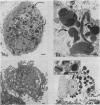Abstract
BACKGROUND: The objective was to characterise the process and consequences of eosinophil activation and lysis in patients with chronic eosinophilic pneumonia and to compare them with those in patients with eosinophil pulmonary infiltrates from other causes. METHODS: Cells from bronchoalveolar lavage fluid of four patients with chronic eosinophilic pneumonia and four patients with eosinophilic infiltrates associated with Sjögren's syndrome, drug hypersensitivity pneumonia, postradiotherapy fibrosis, and pulmonary disease associated with graft versus host disease were studied ultrastructurally and with immunogold labelled antibodies directed against eosinophil proteins: major basic protein, eosinophil cationic protein, and Charcot-Leyden crystal protein. The concentration of eosinophil cationic protein was also measured in bronchoalveolar fluid. RESULTS: In the four patients with chronic eosinophilic pneumonia, ultrastructural studies demonstrated numerous lysed eosinophils. Further, three released eosinophil proteins were detected in distinct cytoplasmic structures in alveolar macrophages. These features were not found in the four patients with eosinophilic pulmonary infiltrates from other causes. CONCLUSION: Eosinophils in chronic eosinophilic pneumonia show signs of activation with release of eosinophil proteins. The appearance of three of these eosinophil proteins in different macrophage compartments suggests that macrophage uptake, with or without intracellular transport of released eosinophil proteins, involves separate mechanisms. This interaction does not lead to macrophage lysis, however, and one or more of these eosinophil proteins might directly affect macrophage function.
Full text
PDF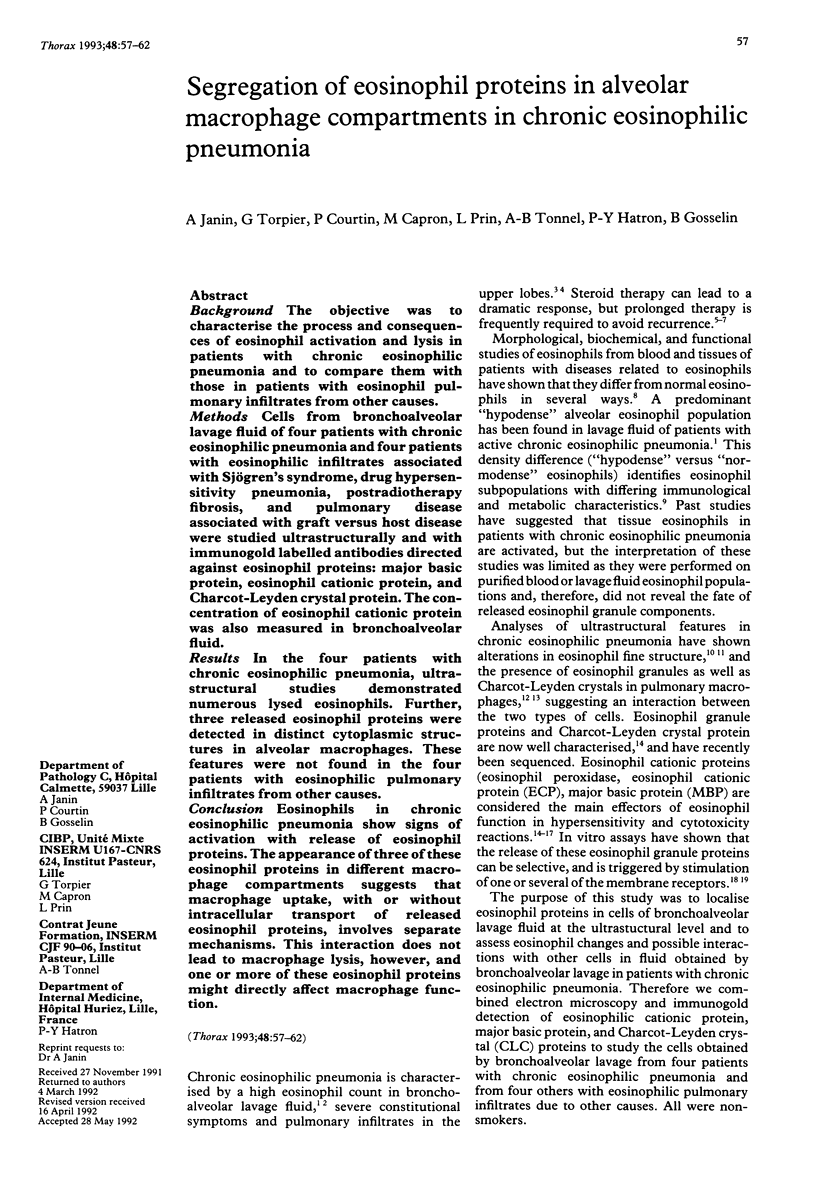
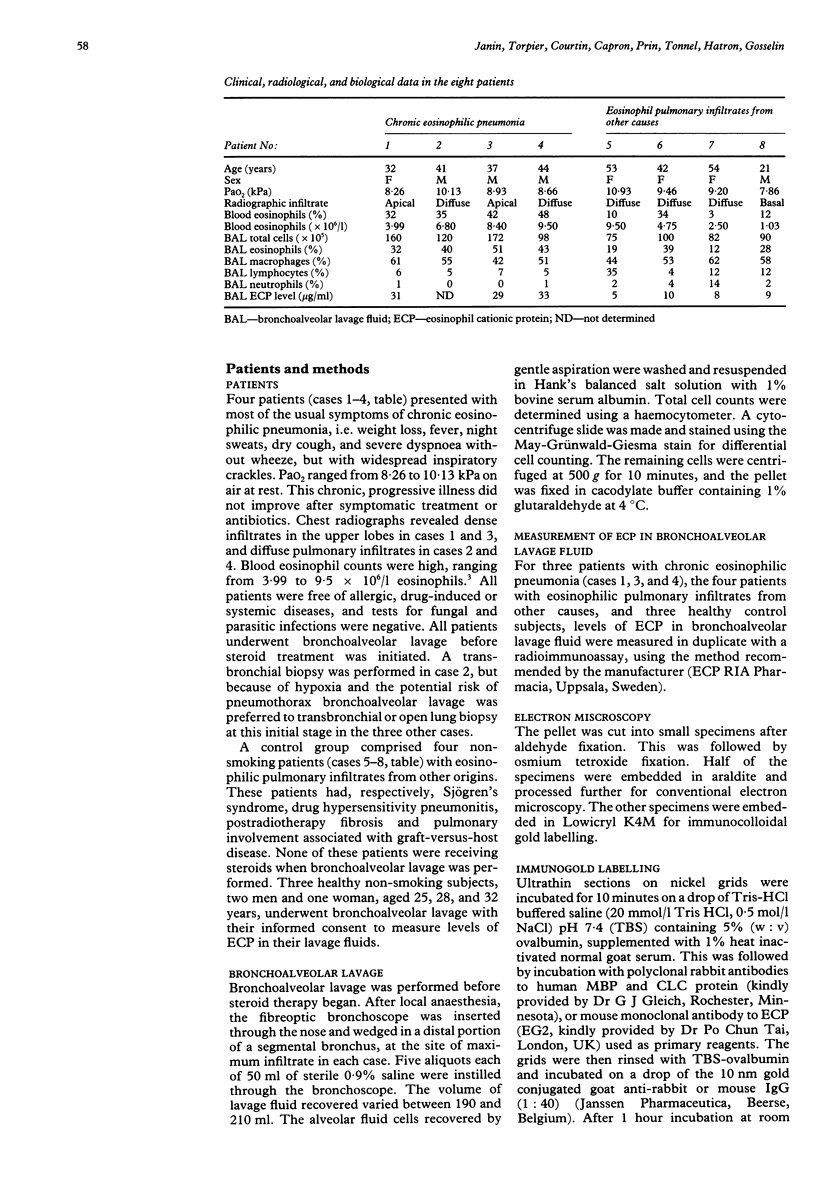
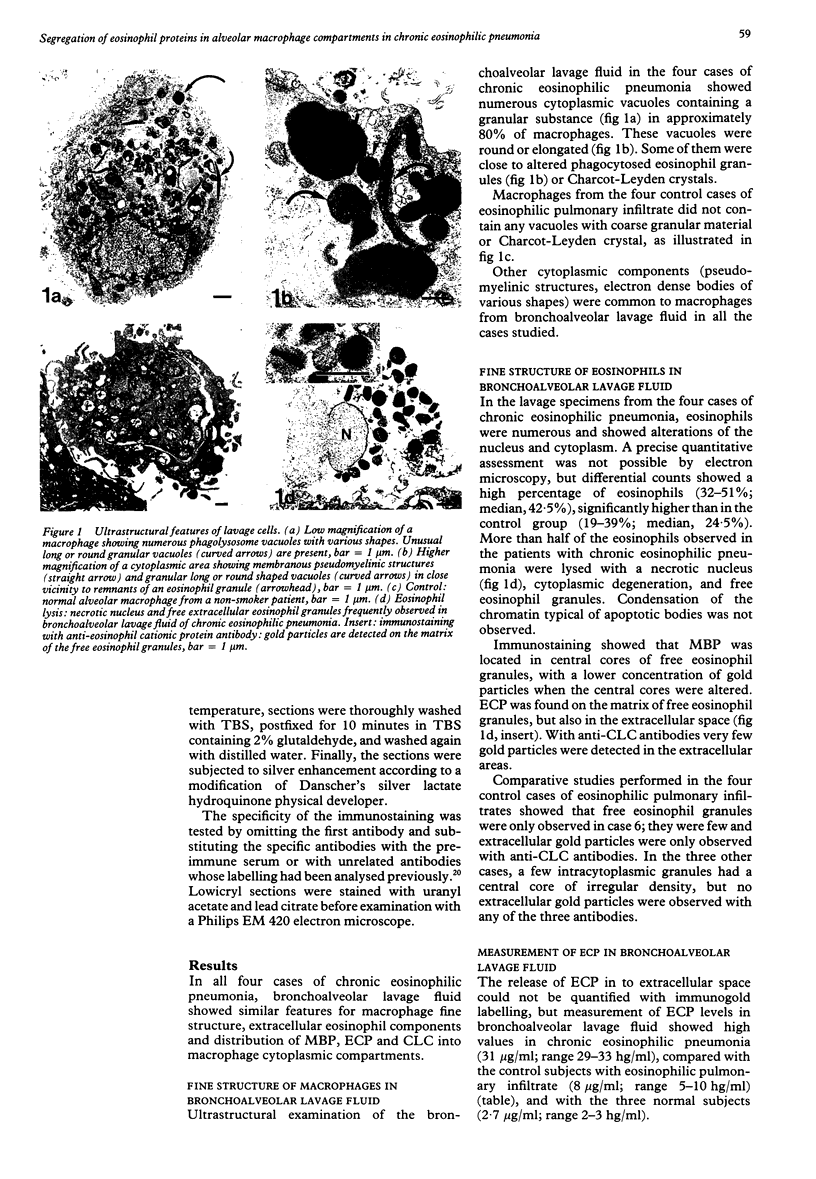
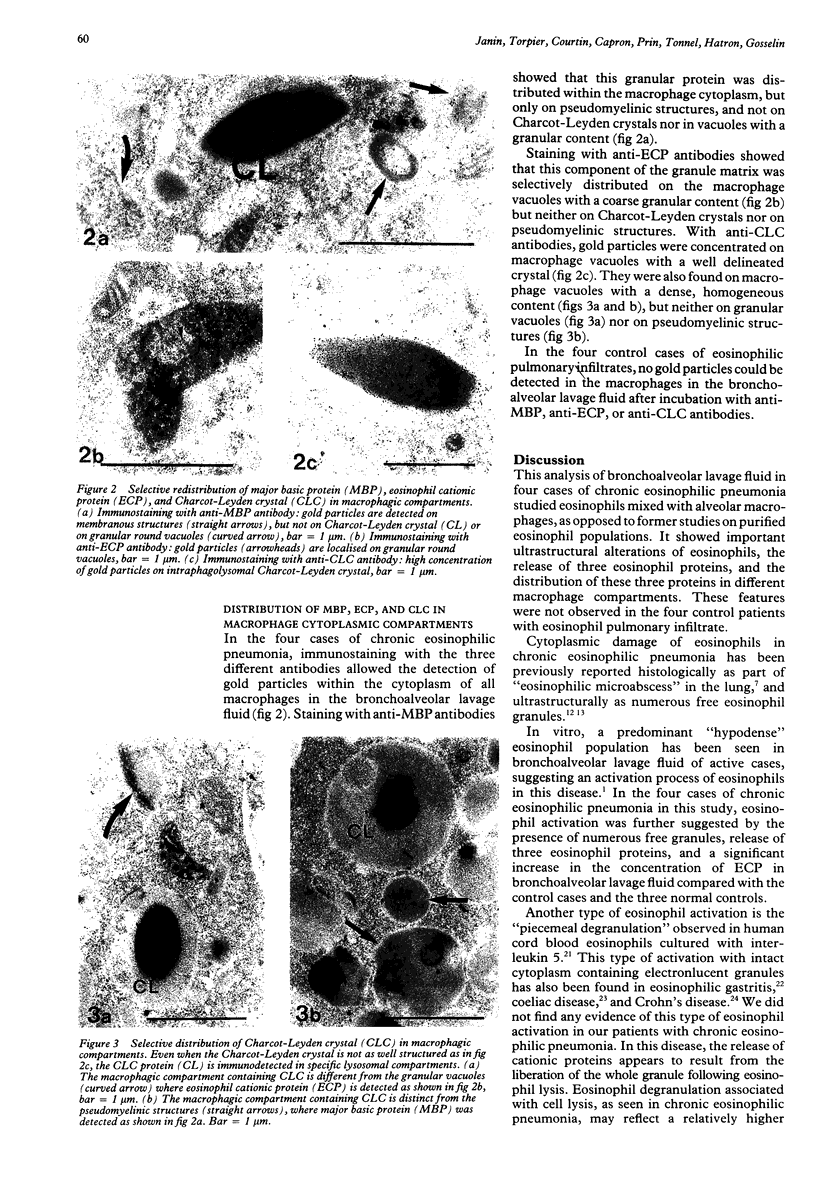
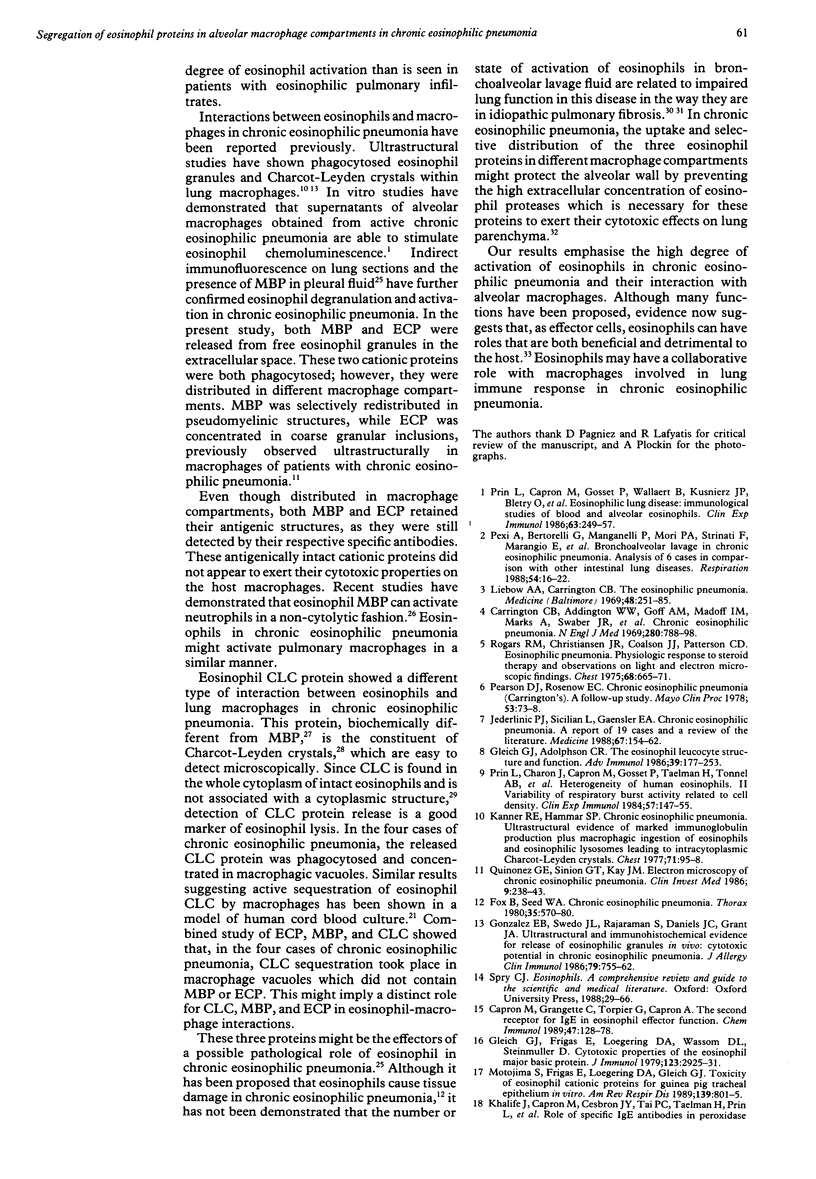
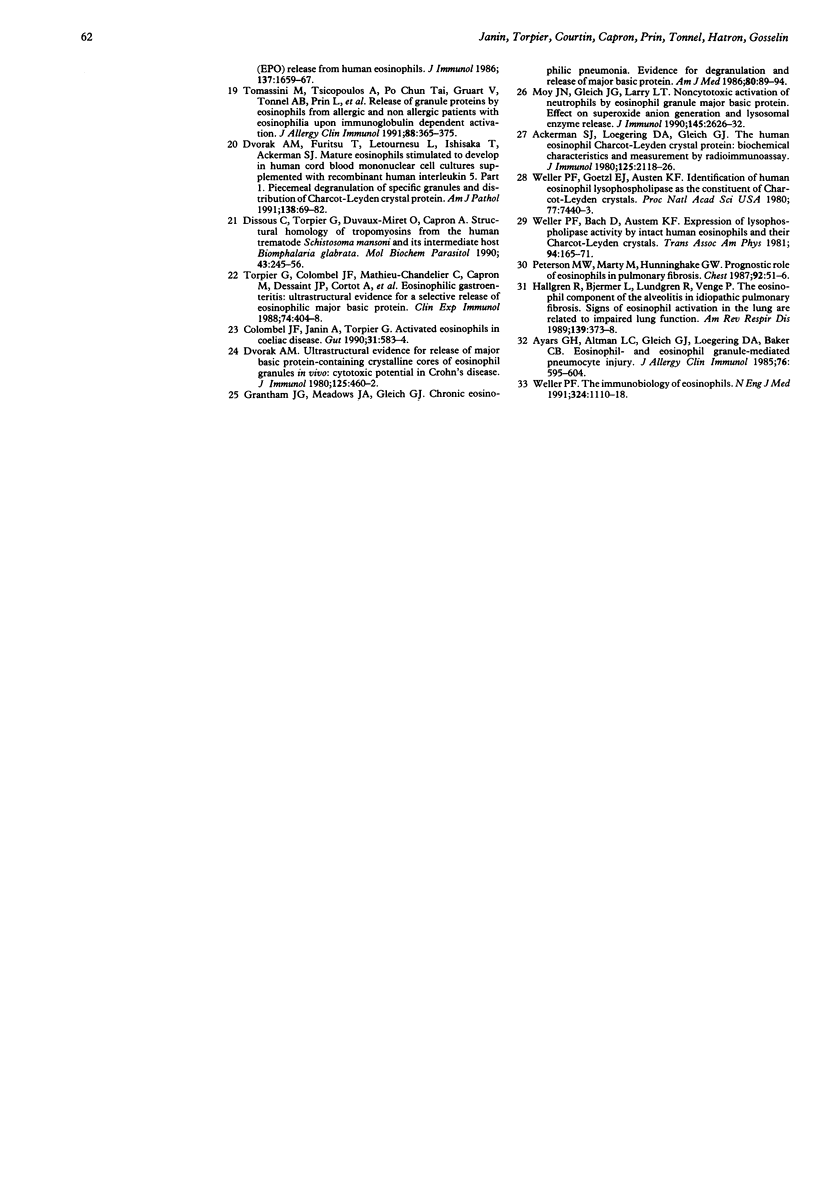
Images in this article
Selected References
These references are in PubMed. This may not be the complete list of references from this article.
- Ackerman S. J., Loegering D. A., Gleich G. J. The human eosinophil Charcot-Leyden crystal protein: biochemical characteristics and measurement by radioimmunoassay. J Immunol. 1980 Nov;125(5):2118–2126. [PubMed] [Google Scholar]
- Ayars G. H., Altman L. C., Gleich G. J., Loegering D. A., Baker C. B. Eosinophil- and eosinophil granule-mediated pneumocyte injury. J Allergy Clin Immunol. 1985 Oct;76(4):595–604. doi: 10.1016/0091-6749(85)90781-x. [DOI] [PubMed] [Google Scholar]
- Capron M., Grangette C., Torpier G., Capron A. The second receptor for IgE in eosinophil effector function. Chem Immunol. 1989;47:128–178. [PubMed] [Google Scholar]
- Colombel J. F., Janin A., Torpier G. Activated eosinophils in coeliac disease. Gut. 1990 May;31(5):583–584. doi: 10.1136/gut.31.5.583. [DOI] [PMC free article] [PubMed] [Google Scholar]
- Dissous C., Torpier G., Duvaux-Miret O., Capron A. Structural homology of tropomyosins from the human trematode Schistosoma mansoni and its intermediate host Biomphalaria glabrata. Mol Biochem Parasitol. 1990 Dec;43(2):245–255. doi: 10.1016/0166-6851(90)90149-g. [DOI] [PubMed] [Google Scholar]
- Dvorak A. M., Furitsu T., Letourneau L., Ishizaka T., Ackerman S. J. Mature eosinophils stimulated to develop in human cord blood mononuclear cell cultures supplemented with recombinant human interleukin-5. Part I. Piecemeal degranulation of specific granules and distribution of Charcot-Leyden crystal protein. Am J Pathol. 1991 Jan;138(1):69–82. [PMC free article] [PubMed] [Google Scholar]
- Dvorak A. M. Ultrastructural evidence for release of major basic protein-containing crystalline cores of eosinophil granules in vivo: cytotoxic potential in Crohn's disease. J Immunol. 1980 Jul;125(1):460–462. [PubMed] [Google Scholar]
- Fox B., Seed W. A. Chronic eosinophilic pneumonia. Thorax. 1980 Aug;35(8):570–580. doi: 10.1136/thx.35.8.570. [DOI] [PMC free article] [PubMed] [Google Scholar]
- Gleich G. J., Adolphson C. R. The eosinophilic leukocyte: structure and function. Adv Immunol. 1986;39:177–253. doi: 10.1016/s0065-2776(08)60351-x. [DOI] [PubMed] [Google Scholar]
- Gleich G. J., Frigas E., Loegering D. A., Wassom D. L., Steinmuller D. Cytotoxic properties of the eosinophil major basic protein. J Immunol. 1979 Dec;123(6):2925–2927. [PubMed] [Google Scholar]
- Gonzalez E. B., Swedo J. L., Rajaraman S., Daniels J. C., Grant J. A. Ultrastructural and immunohistochemical evidence for release of eosinophilic granules in vivo: cytotoxic potential in chronic eosinophilic pneumonia. J Allergy Clin Immunol. 1987 May;79(5):755–762. doi: 10.1016/0091-6749(87)90207-7. [DOI] [PubMed] [Google Scholar]
- Grantham J. G., Meadows J. A., 3rd, Gleich G. J. Chronic eosinophilic pneumonia. Evidence for eosinophil degranulation and release of major basic protein. Am J Med. 1986 Jan;80(1):89–94. doi: 10.1016/0002-9343(86)90053-7. [DOI] [PubMed] [Google Scholar]
- Hällgren R., Bjermer L., Lundgren R., Venge P. The eosinophil component of the alveolitis in idiopathic pulmonary fibrosis. Signs of eosinophil activation in the lung are related to impaired lung function. Am Rev Respir Dis. 1989 Feb;139(2):373–377. doi: 10.1164/ajrccm/139.2.373. [DOI] [PubMed] [Google Scholar]
- Jederlinic P. J., Sicilian L., Gaensler E. A. Chronic eosinophilic pneumonia. A report of 19 cases and a review of the literature. Medicine (Baltimore) 1988 May;67(3):154–162. doi: 10.1097/00005792-198805000-00002. [DOI] [PubMed] [Google Scholar]
- Kanner R. E., Hammar S. P. Chronic eosinophilic pneumonia. Ultrastructural evidence of marked immunoglobulin production plus macrophagic ingestion of eosinophils and eosinophilic lysosomes leading to intracytoplasmic Charcot-Leyden crystals. Chest. 1977 Jan;71(1):95–98. doi: 10.1378/chest.71.1.95. [DOI] [PubMed] [Google Scholar]
- Khalife J., Capron M., Cesbron J. Y., Tai P. C., Taelman H., Prin L., Capron A. Role of specific IgE antibodies in peroxidase (EPO) release from human eosinophils. J Immunol. 1986 Sep 1;137(5):1659–1664. [PubMed] [Google Scholar]
- Liebow A. A., Carrington C. B. The eosinophilic pneumonias. Medicine (Baltimore) 1969 Jul;48(4):251–285. doi: 10.1097/00005792-196907000-00001. [DOI] [PubMed] [Google Scholar]
- Motojima S., Frigas E., Loegering D. A., Gleich G. J. Toxicity of eosinophil cationic proteins for guinea pig tracheal epithelium in vitro. Am Rev Respir Dis. 1989 Mar;139(3):801–805. doi: 10.1164/ajrccm/139.3.801. [DOI] [PubMed] [Google Scholar]
- Moy J. N., Gleich G. J., Thomas L. L. Noncytotoxic activation of neutrophils by eosinophil granule major basic protein. Effect on superoxide anion generation and lysosomal enzyme release. J Immunol. 1990 Oct 15;145(8):2626–2632. [PubMed] [Google Scholar]
- Pearson D. L., Rosenow E. C., 3rd Chronic eosinophilic pneumonia (Carrington's): a follow-up study. Mayo Clin Proc. 1978 Feb;53(2):73–78. [PubMed] [Google Scholar]
- Pesci A., Bertorelli G., Manganelli P., Mori P. A., Strinati F., Marangio E., Olivieri D. Bronchoalveolar lavage in chronic eosinophilic pneumonia. Analysis of six cases in comparison with other interstitial lung diseases. Respiration. 1988;54 (Suppl 1):16–22. doi: 10.1159/000195475. [DOI] [PubMed] [Google Scholar]
- Peterson M. W., Monick M., Hunninghake G. W. Prognostic role of eosinophils in pulmonary fibrosis. Chest. 1987 Jul;92(1):51–56. doi: 10.1378/chest.92.1.51. [DOI] [PubMed] [Google Scholar]
- Prin L., Capron M., Gosset P., Wallaert B., Kusnierz J. P., Bletry O., Tonnel A. B., Capron A. Eosinophilic lung disease: immunological studies of blood and alveolar eosinophils. Clin Exp Immunol. 1986 Jan;63(1):249–257. [PMC free article] [PubMed] [Google Scholar]
- Quinonez G. E., Simon G. T., Kay J. M. Electron microscopy of chronic eosinophilic pneumonia. Clin Invest Med. 1986 Nov;9(4):238–243. [PubMed] [Google Scholar]
- Tomassini M., Tsicopoulos A., Tai P. C., Gruart V., Tonnel A. B., Prin L., Capron A., Capron M. Release of granule proteins by eosinophils from allergic and nonallergic patients with eosinophilia on immunoglobulin-dependent activation. J Allergy Clin Immunol. 1991 Sep;88(3 Pt 1):365–375. doi: 10.1016/0091-6749(91)90099-a. [DOI] [PubMed] [Google Scholar]
- Torpier G., Colombel J. F., Mathieu-Chandelier C., Capron M., Dessaint J. P., Cortot A., Paris J. C., Capron A. Eosinophilic gastroenteritis: ultrastructural evidence for a selective release of eosinophil major basic protein. Clin Exp Immunol. 1988 Dec;74(3):404–408. [PMC free article] [PubMed] [Google Scholar]
- Weller P. F., Bach D., Austen K. F. Expression of lysophospholipase activity by intact human eosinophils and their Charcot-Leyden crystals. Trans Assoc Am Physicians. 1981;94:165–171. [PubMed] [Google Scholar]
- Weller P. F., Goetzl E. J., Austen K. F. Identification of human eosinophil lysophospholipase as the constituent of Charcot-Leyden crystals. Proc Natl Acad Sci U S A. 1980 Dec;77(12):7440–7443. doi: 10.1073/pnas.77.12.7440. [DOI] [PMC free article] [PubMed] [Google Scholar]



